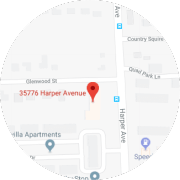Anti Glare Lens Treatment
Standard lenses can reflect up to 18 percent of light-causing glare and eye strain from sources such as fluorescent lighting, computer screens, and headlights. With Anti-Glare lens treatment, only 1% of light is reflected off the surface of the lens. With 99% of light passing through your lenses to your eyes, glare and eye strain is reduced to a minimum. In comparison to standard lenses, you will also see much clearer and sharper.
Anti-glare lens treatment makes driving at night safer too, as it virtually eliminates glare from oncoming headlights and streetlights. Overhead fluorescent lights and computer screens can cause glare and eye strain which will be minimized with this Anti-glare lens treatment. Anti-glare treatment also eliminates light reflecting off the surface of your lenses. After all, you are choosing your frames to enhance your appearance. You want others to see your eyes and not be distracted by the glare reflecting off your lenses.
Lenses treated with Anti-Glare enhance the scratch resistant properties of standard scratch-resistant lenses and will help repel water, fingerprints, oil, and dust. This allows you to spend less time cleaning them… and a longer life for your lenses.
Digital Lenses
The manufacturing processes used to make today’s conventional lenses were invented in the early 20th century. This method is not ideal for all lens prescriptions or for all frame designs. Conventional lenses provide their optimum clarity through the optical center of the lens. In subsequent zones outside of the optical center, the optical performance becomes less and less. So, the further you look away from the center of your lens, the clarity of your vision diminishes.
For high prescriptions and progressive lenses, that have their near and distant vision provided by zones outside of the optical center, this effect is even more noticeable. This reduction of clarity is caused when light rays from the lateral surfaces of the lens are bent in such a way that they focus slightly in front of the retina instead of directly on the retina.
New Digital-Free Form lens manufacturing technology now allows manufacturers to create customized High Definition Lenses. This process involves modifying the entire back surface of the lens in such a way as to re-direct light rays from every direction of sight, to focus directly on the retina.
These High Definition Lenses optimize all viewing zones giving you clearer vision throughout your entire lens. High Definition Lenses are six times more accurate than conventional lenses and the digital manufacturing technology can make your lenses even more personalized by taking into account your prescription, your frame measurements as well as your position of wear. A good comparison for how you might see with digital lenses is similar to the difference you would see between a standard television screen with fewer pixels and a high definition television screen with many more pixels.
Progressive lens wearers especially enjoy even greater benefits from this improved manufacturing technology due to its ability to provide wider fields of clearer vision within all zones of power; near, intermediate and distance. By including an Anti-glare treatment, you will enjoy the crispest and clear vision modern lens manufacturing technology can provide.
Computer Lenses
Do you spend much of your day sitting in front of a computer or do you have hobbies or other work that require you to focus at arm’s length? Do you ever experience shoulder and neck pain, develop headaches or experience eye strain from doing these activities for a prolonged amount of time. Do you wear progressive lenses and find it difficult to hold your head in just the right position to see clearly during these activities? If so, there are lenses designed specifically to help you with these tasks. These lenses are commonly referred to as “computer lenses” as initially many people used them while working on their computers.
However, these lenses are also ideal for a multitude of near and intermediate activities by making it easier for your eyes to focus and help relieve eye strain often experienced during these tasks. They also help alleviate neck and shoulder pain by allowing a more natural and relaxed posture. Computer lenses are an excellent choice for a second pair of glasses for tasks that demand a long period of intermediate vision, but they are not intended to replace your everyday eyewear.
High Index Lenses:
- Unattractive, thick and heavy lenses are, for the most part, a thing of the past, with the advent of High Index Lenses.
- Recent advances in lens material technology can now make even the highest power prescriptions appear more attractive than ever before.
- High index lenses provide the same vision as your old lenses but they will be lighter and appear much thinner.
- And, because high index lenses are thinner, many more frame materials and styles will be available for your previously challenging prescription.
- The performance of high index lenses is often complemented with the addition of the Anti-glare lens treatment to minimize reflections and maximize their cosmetic benefits.
Impact Resistant Lenses
Who needs impact resistant lenses? The answer is EVERYBODY. From kids on the playground to construction workers around heavy machinery, there is always the potential for standard lens materials, such as plastic or glass, to shatter, even from the impact of an airbag in an automobile accident.
You can protect your precious vision with impact resistant lenses. These lenses are manufactured using an injection molding process which makes them stronger than standard lens materials and includes scratch resistance protection. Impact resistant lenses also protect your eyes from the harmful effects of excessive Ultra-Violet light exposure. They are the lightest weight lens material you can purchase and may be thinner than your previous plastic lenses.
Light Reactive Variable Tint Lenses
Do you spend a large portion of your day going inside than outside again? Are you constantly having to change from your clear glasses to your sunglasses? Light Reactive Lenses or Variable Tint lenses automatically adjust to your changing light environment, continually providing you with the optimal amount of lens tint. When inside, the lenses are clear similar to standard lenses. But when you go outside, they react to ultraviolet light, automatically darkening, transforming them into sunglasses. These lenses are scratch resistant and also include the additional benefits of providing UV protection for your eyes. Having a pair of Light Reactive Variable Tint Lenses may eliminate your need for more than one pair of glasses for most of your normal activities.
Polarized Sunglasses
The worst type of glare is blinding glare. Most over-the-counter sunglasses are ineffective at reducing blinding glare caused by light reflecting surfaces such as water… ice… and snow.
Polarized sun lenses are very effective in eliminating blinding glare. Traditionally thought of as summer essentials, they also provide increased clarity, contrast and depth perception. But they are just as effective in winter, eliminating blinding glare often experienced in snowy and icy conditions. Blinding glare is annoying but is also dangerous especially when driving. Studies have proven that driving with polarized lenses is safer. When driving at 50 mph, study participants got an additional 23 feet of stopping distance wearing polarized lenses when compared to those wearing ordinary sunglasses. Not all polarized lenses are equal in quality. Over-the-counter sunglasses that say they are polarized may block some types of Ultra-violet, or UV light rays, but they may not fully protect your eyes from developing cataracts or macular degeneration which have been associated with excessive UV exposure.
Our full spectrum polarized lenses block both UVA and UVB light rays, include scratch protection, and are available in a wide variety of colors and frame styles to compliment your favorite outdoor activity. Make sure your sunglasses are not only fashionable but that they fully protect your eyes from the negative effects of UV light and provide the vision you need when experiencing dangerous blinding glare.
Progressive Lenses
When we are young, the lens inside the eye is soft and flexible. To change focus from near to distant and back again, the muscles surrounding the natural lens contract and relax changing the optical power of the lens. This ability of the lens to change its shape and focus is called accommodation.
Around the age of 40, a condition known as presbyopia develops when we lose the ability to change the shape of the lens inside the eye. As this occurs, we become more and more dependent on reading glasses to see close objects.
Benjamin Franklin invented a way to correct this condition with bi-focal lenses back in 1784. Today, progressive lenses are available that have the appearance of single vision lenses while providing you with a full range of vision from near, to intermediate, to distance.
Progressive lenses are created with a gradient of power starting with the patient’s distance prescription at the top of the lens, a stronger intermediate power in the middle of the lens, and the strongest near power at the bottom of the lens. This seamless gradient of power zones allows patients to easily shift their focus from distance to intermediate, to near, without the visual interference of lined bifocal or trifocal lenses. If you experienced trouble in the past choosing a frame that would accommodate a progressive lens, there are now many progressive lens designs available for virtually any style of frame.

 586-792-3891
586-792-3891




